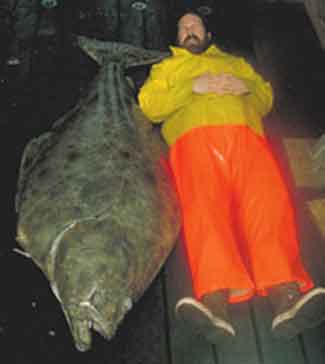

FBE Focal Species - Pacific Halibut
 Pacific halibut (Hippoglossus stenolepis) is one of the most valuable fishery resources for both commercial and recreational fishers in the North Pacific Ocean because of its high price and large size. Halibut, which range from the Sea of Japan to Baja California, is most abundant from Oregon to Alaska. Populations have been monitored and managed by the International Pacific Halibut Commission for almost 80 years. During this time, landings have been relatively consistent, near 25,000 metric tons per year, and currently they are valued at $126 million. Fishing for halibut is limited to hook and line capture, and all halibut captured by other means must be returned to the sea. Halibut landings and bycatch are carefully monitored and trawl fisheries in the Bering Sea are often limited by calculations related to bycatch mortality. Pacific halibut (Hippoglossus stenolepis) is one of the most valuable fishery resources for both commercial and recreational fishers in the North Pacific Ocean because of its high price and large size. Halibut, which range from the Sea of Japan to Baja California, is most abundant from Oregon to Alaska. Populations have been monitored and managed by the International Pacific Halibut Commission for almost 80 years. During this time, landings have been relatively consistent, near 25,000 metric tons per year, and currently they are valued at $126 million. Fishing for halibut is limited to hook and line capture, and all halibut captured by other means must be returned to the sea. Halibut landings and bycatch are carefully monitored and trawl fisheries in the Bering Sea are often limited by calculations related to bycatch mortality.
The Pacific halibut is the largest flatfish known, with females living 40 years or more and reaching 2.5 m and 300 kg. Males are smaller (1.5 m) and have shorter maximum life spans, near 25 years. Spawning occurs during the winter in deep water (180-450 m) along the continental slope at a number of well known locations in the Bering Sea, Aleutian Islands, and Gulf of Alaska south to British Columbia. Females spawn repeatedly over the season, producing as many as 2 million eggs. The eggs develop at depth and larvae remain in the water column for as long as 7 months. As they develop, the larvae move to shallower water and young-of-the-year juveniles (30 mm and larger) are common in shallow, near-shore waters 2-50 m deep in Alaska and British Columbia. Small juveniles consume small crustaceans and other benthic organisms, and become largely piscivorous by 30 cm during their second year. With increasing age and size, the fish move to deeper water and migrate south to the fishing grounds in Washington and Oregon. The connectivity between Bering Sea and Gulf of Alaska populations is poorly understood.
Focal Species Links:
Last updated
14 March, 2007
FBE Webmaster
|